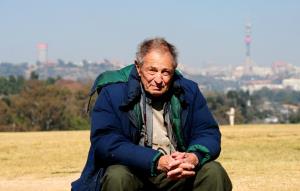
Legendary photographer David Goldblatt was there to document the onset of apartheid and there to take a portrait of a free Nelson Mandela. Today, he’s still far from packing away his lenses, writes Charl Blignaut
The first time David Goldblatt photographed Nelson Mandela was in 1952 at a meeting of the ANC at the Trades Hall in Johannesburg. The leadership was on stage to discuss the new defiance campaign against unjust apartheid laws.
“I was the only person there with a camera, except possibly the security police ... I think (Albert) Luthuli was there, Mandela, (Walter) Sisulu, Lillian Ngoyi, many of them ... and it was a very impassioned meeting. In those days, there was no toyi-toying, but there was a lot of singing,” he says.
Those images should be world famous today. “I had my first Leica camera and I photographed for about two hours, and then I thought it was very strange, it was a very long piece of film. I opened the back of the camera and it had not engaged the film. I had nothing.”
I tell him he must have been devastated, but he chuckles. “It was an abject lesson in telling me that I was not destined to be a news photographer.”
We meet the grand old man of South African photography – part social documenter, part artist, seldom photojournalist – at his home in a leafy suburb of central Johannesburg. He has lived here with his wife, Lily, for more than 45 years. It was the first house they bought and they are renovating it for the first time.
“When I told you to meet me at home, they were supposed to be finished, but of course they aren’t. I suppose in my head I was wishing they were,” he says, annoyed.
There is something to be admired about this renovating. At 82, many are considering an old age home. Instead, the spry man with electric grey eyes and scruffy hair climbs into his camper van and asks me to join him.
We’ll go to a coffee shop instead. This is the vehicle in which he travels the country, on a mission to document post-apartheid public art while working on a side project documenting criminals at the scenes of their crimes.
Goldblatt says he has no strong views on portraiture. “It’s all just photography.” But he has been known to quote Bill Brandt’s view that a great portrait will give a sense of where a person has been and also where they are going.
Looking at Goldblatt’s portrait of the Nelson Mandela who was about to become president in 1994, there is a sense of hardship etched in wrinkles and human failing in the form of a visible hearing aid, which neatly demythologises the icon.
Yet here is also a man looking ahead to a new dawn. It’s a serious, workmanlike image of a man normally depicted in the tone of his presidency – smiling and dancing. It’s one of the great presidential portraits.
“We had an appointment with Mandela in Houghton at five in the morning,” says Goldblatt. “We came in there, and I looked around the living room, or rooms, and they were filled with what I call Gomma Gomma furniture. Soft, ‘plungeable’ stuff.”
A good example of the photographer’s dry, ready wit is that he has been known to depict people he is not fond of seated in such furniture. “I remember putting (apartheid minister) Chris Heunis into one of those ... ”
When he asked for a straight-back kitchen chair to photograph Mandela, it displeased press officer Carl Niehaus. “I said: ‘I’ve come here to photograph Mr Mandela, not the furniture. May I please have a kitchen chair.’ It went to and fro a little bit, with me insisting, because I’d been through that movie before with the president of Mozambique, with PW Botha, all these various people ... But that was the thing to do. I wanted the essential Mandela, and not Mandela in a suburban context. It was a very straightforward picture.”
Portraiture, however, is not what Goldblatt is known for. Growing up Jewish in Randfontein, he experienced relentless anti-Semitism, which helped forge his hatred of apartheid.
With two brothers going off to war, the reality of Nazism was real to him – and he saw its appeal among the Afrikaners who would go on to create apartheid.
Goldblatt became known for his everyday, black-and-white images of those who colluded with apartheid.
He never hits his audience over the head with a message though. You can draw your own conclusions about white women parading in a beauty pageant in a Boksburg shopping centre while black girls watch them from the audience.
“I had a deep sense of wanting to penetrate to the core of things here, and to somehow grasp the fundamentals of Afrikaner nationalism, its underlying spirit.”
He recalls the shock of apartheid being legislated and implemented, the “whites only” signs going up. One of his great images is of a black man climbing the stairs of the Joburg station with a policeman standing at the top. You need to work to draw meaning from it.
“Joburg station was a mixed place, but suddenly it became separated. The policeman told the man to go back. This area was now for whites,” he explains.
Goldblatt is a man who orders rye toast with olive oil and green tea for breakfast. A man of simple needs and complex images. An “anti-sensationalist” as one critic put it. “A slow photographer in a fast food world,” says academic John Edwin Mason.
If apartheid had never happened, he says, he may never have become a photographer. It was only when his father died, though, and he could sell the family shop, that he was free to take up the camera full time.
Today, he has honorary doctorates bestowed on him and has won every major award in photography. He has had more than a dozen books of photographs published. The first was about mining in South Africa, an issue so relevant today that the book was recently republished.
But fame was not on the cards when he first visited America as a young man.
“These publishers in New York would ask me: ‘But where’s the apartheid man? We want to see the apartheid.’ And of course it was endemic in almost all of the photographs. But then it becomes like explaining a joke and it ceases to be funny. It was a painful realisation. When I came back, I realised that if I belonged anywhere in the world, it was here, and if I was speaking to anybody outside of my own inside, it was to my compatriots. And so the rest followed.
“When I got some recognition overseas, it was very nice. But to me it’s not an essential; it’s not what it’s about ... ”
Goldblatt is still speaking to South Africans – now about the legacy of our complicated democracy.
Whether it’s an image of the inaccessible and untended monument to the Cradock Four or of the terrible beauty of the hopeful new sculpture on the campus of the race-torn Free State University, he is trying to capture the ethos of our times.
“Even though there is hardly a person in any of those photographs, I never felt for a moment that this was devoid of humanity. It was about us.
“So, in reverse, as it were, I feel the same about these portraits. They’re about us. I don’t have any strong feelings about portraiture. To me, it’s really just a photograph.”
We take a walk in the park, the legendary photographer and I. We talk about the colour of the sky – how in black and white its tourist-brochure blue goes dark and sinister.
“I didn’t use colour at all for my personal work during apartheid. I think that if you want to express anger, and fear, and disgust, and want to penetrate to the core of things, black and white is the medium.”
But he’s been working in colour more often nowadays, still developing at 82.
“After liberation, as it were, I felt that I needed to move into a new area, and so colour was the obvious one.”




 Publications
Publications
 Partners
Partners








